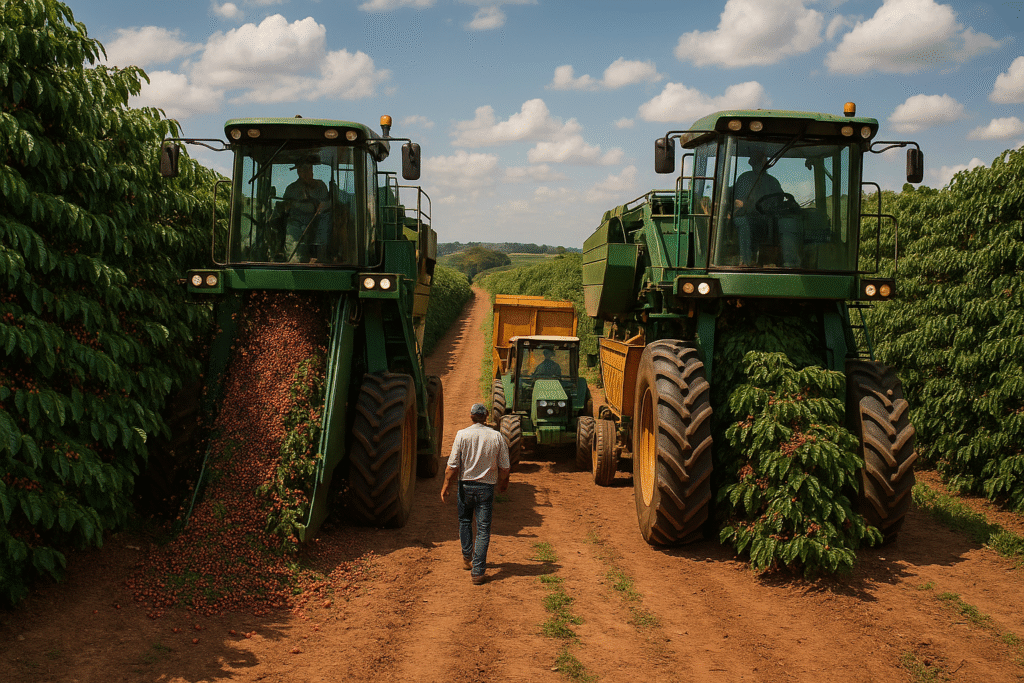Coffee is one of the world’s most traded commodities, with millions of bags exported annually from tropical regions around the globe. While many romanticize coffee as a product of small, artisanal farms, a large percentage of the global supply comes from massive plantations that operate with scale, efficiency, and precision. But how exactly is coffee harvested on these large farms?
In this article, we’ll explore how coffee is grown and harvested on an industrial level, the types of harvesting techniques used, the technologies involved, and the challenges that come with large-scale coffee production.
Understanding Coffee Plantations
Large coffee plantations are typically located in regions with ideal growing conditions: consistent rainfall, moderate temperatures, fertile soil, and elevations between 600 and 2,000 meters. In countries like Brazil, Colombia, and Vietnam, these plantations can span hundreds or even thousands of hectares and produce millions of kilograms of coffee per year.
Plantations are often organized in precise rows of coffee trees, allowing easy access for machinery and laborers. Most large farms grow Arabica, Robusta, or a combination of both, depending on the altitude and regional climate.
When Is Coffee Harvested?
The coffee harvest season varies by region but typically occurs once per year. The timing depends on the rainy and dry seasons:
- Brazil: May to September
- Colombia: Two harvests — main (September to December) and mitaca (April to June)
- Vietnam: October to February
- Ethiopia: November to February
Harvesting only begins when the cherries reach full ripeness — that is, when they turn a deep red or yellow, depending on the variety.
Types of Coffee Harvesting Methods
There are two main methods of harvesting coffee on plantations: selective picking and strip picking. Each has different implications for quality, cost, and efficiency.
Selective Picking
This method involves harvesting only the ripe cherries by hand. Workers move through the fields and pick cherries individually, leaving unripe ones to mature. This is the most labor-intensive method but yields higher-quality coffee because only the best cherries are selected.
Large plantations may still use this method in areas with steep terrain or for specialty coffee lots, where quality is prioritized over volume.
Strip Picking
More common on large plantations, this method involves removing all cherries from a branch at once — either by hand or mechanically. It’s much faster but less selective, meaning ripe and unripe cherries are harvested together and must be sorted later.
Strip picking is often used for Robusta or commodity-grade Arabica destined for blends, instant coffee, or industrial use.
Mechanical Harvesting: Efficiency on a Grand Scale
To reduce labor costs and speed up harvesting, many large plantations employ mechanized harvesters. These are large, tractor-like machines that straddle rows of coffee trees and shake the branches, causing the cherries to fall onto a conveyor belt.
Advantages of Mechanical Harvesting:
- Fast and cost-effective
- Ideal for flat or gently sloped terrain
- Allows for large volumes to be harvested quickly
Disadvantages:
- Less selective than hand-picking
- Can damage trees and unripe cherries
- Requires significant investment in equipment and maintenance
Despite its drawbacks, mechanical harvesting is the preferred method on large Brazilian coffee farms due to the country’s vast flat terrain and labor challenges.
Sorting and Processing After Harvest
Once the cherries are harvested, the next step is to separate ripe from unripe fruit, remove debris, and begin processing. Large plantations often use advanced equipment for:
- Density sorting (ripe cherries sink in water, unripe ones float)
- Color sorting machines that use cameras and lasers to detect defects
- Conveyor belts to transport cherries efficiently between stages
Common Processing Methods:
- Washed (wet) processing: Cherries are pulped and fermented to remove mucilage, then dried. Produces cleaner, brighter flavors.
- Natural (dry) processing: Cherries are dried whole, often in the sun. Produces heavier, fruitier profiles.
- Honey processing: A hybrid method leaving some mucilage on the bean during drying.
Each method affects the final taste and depends on regional traditions, water availability, and desired cup profile.
Labor Considerations and Worker Welfare
Even with machines, human labor is still vital on plantations — especially for maintenance, sorting, and quality control. During harvest season, farms often hire hundreds of seasonal workers. Their tasks include:
- Hand-picking where machines can’t reach
- Sorting cherries at collection points
- Operating machinery and quality checks
Large plantations are increasingly held to ethical standards, with pressure from consumers and certifying bodies (like Rainforest Alliance and Fair Trade) to provide:
- Fair wages and working conditions
- Access to housing and healthcare
- Environmental protections and sustainability measures
Environmental Impact of Large-Scale Harvesting
Massive plantations must also manage the ecological impact of their operations. Challenges include:
- Soil erosion from machinery and over-planting
- Water usage in processing
- Loss of biodiversity in monoculture systems
- Carbon emissions from heavy equipment
However, many large farms now implement sustainable practices, such as:
- Planting shade trees
- Recycling water in processing
- Using renewable energy
- Practicing crop rotation and organic fertilization
Final Thoughts: Balancing Scale with Sustainability
Coffee harvesting on large plantations is a complex, highly organized operation that blends tradition with technology. While efficiency is key to meeting global demand, responsible producers are learning to balance scale with sustainability and ethics.
Whether your coffee comes from a boutique farm or a massive plantation, every bean represents a monumental effort — from planting and tending to harvesting and sorting. Understanding how coffee is harvested at scale helps us appreciate the journey it takes before reaching our cups.
